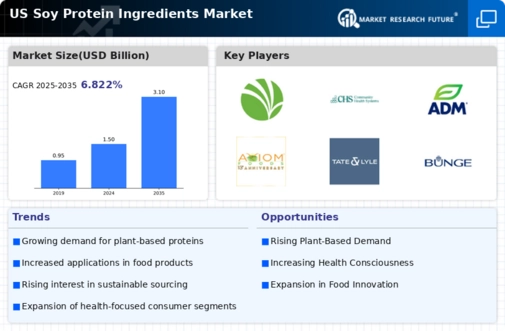Health Consciousness Among Consumers
The increasing health consciousness among consumers is a pivotal driver for the soy protein-ingredients market. As individuals become more aware of the nutritional benefits associated with plant-based proteins, the demand for soy protein ingredients is likely to rise. Research indicates that soy protein is a complete protein, containing all essential amino acids, which appeals to health-focused consumers. In the US, the market for plant-based proteins is projected to grow at a CAGR of approximately 8% from 2023 to 2028, indicating a robust interest in healthier dietary options. This trend is further fueled by the rising prevalence of lifestyle-related diseases, prompting consumers to seek alternatives that support their health goals. Consequently, the soy protein-ingredients market is positioned to benefit from this shift towards healthier eating habits.
Rising Popularity of Meat Alternatives
The rising popularity of meat alternatives is a crucial driver for the soy protein-ingredients market. As consumers increasingly seek substitutes for traditional meat products, soy protein ingredients are often utilized due to their texture and protein content. The US market for meat alternatives is projected to reach $4.5 billion by 2026, with soy protein playing a vital role in this growth. This trend is driven by a combination of health concerns, environmental considerations, and ethical factors surrounding animal welfare. Consequently, food manufacturers are incorporating soy protein into a variety of products, including burgers, sausages, and dairy alternatives, thereby expanding the market reach of soy protein ingredients. This shift not only supports the soy protein-ingredients market but also encourages innovation in product development.
Growth of the Vegan and Vegetarian Population
The growth of the vegan and vegetarian population in the US serves as a significant driver for the soy protein-ingredients market. As more individuals adopt plant-based diets for ethical, environmental, or health reasons, the demand for soy protein ingredients is expected to increase. According to recent surveys, approximately 5% of the US population identifies as vegan, with an additional 3% as vegetarian, reflecting a notable shift in dietary preferences. This demographic shift is likely to create a sustained demand for soy protein products, as they are often favored for their versatility and nutritional profile. Furthermore, the soy protein-ingredients market is likely to see innovations in product formulations to cater to this growing consumer base, enhancing the appeal of soy-based products in various food applications.
Technological Advancements in Food Processing
Technological advancements in food processing are likely to drive the soy protein-ingredients market forward. Innovations in extraction and processing techniques have improved the quality and functionality of soy protein ingredients, making them more appealing to food manufacturers. Enhanced processing methods can lead to better texture, solubility, and flavor profiles, which are crucial for product acceptance in the competitive food industry. As the US food sector continues to evolve, the incorporation of advanced technologies is expected to facilitate the development of new soy-based products. This trend may result in a broader application of soy protein ingredients across various food categories, thereby expanding market opportunities. The ongoing research and development efforts in food technology could further enhance the market's growth trajectory.
Increased Focus on Sustainable Food Production
An increased focus on sustainable food production is emerging as a key driver for the soy protein-ingredients market. As consumers and manufacturers alike prioritize sustainability, the demand for plant-based proteins, including soy, is likely to grow. Soy protein is often viewed as a more sustainable alternative to animal-based proteins, given its lower environmental impact in terms of land and water usage. The US government has also been promoting sustainable agricultural practices, which may further bolster the soy protein-ingredients market. This alignment with sustainability goals is expected to attract environmentally conscious consumers, thereby enhancing the market's growth potential. Additionally, food brands are increasingly marketing their products as sustainable, which could further elevate the profile of soy protein ingredients in the marketplace.



















Leave a Comment